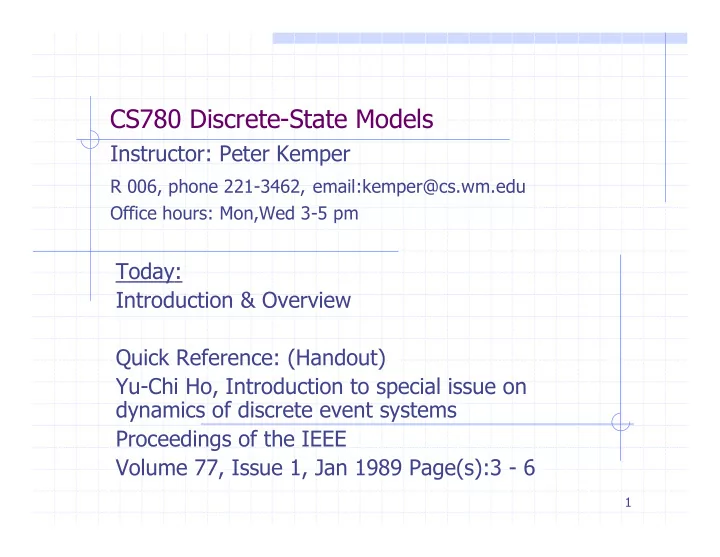

CS780 Discrete-State Models Instructor: Peter Kemper R 006, phone 221-3462, email:kemper@cs.wm.edu Office hours: Mon,Wed 3-5 pm Today: Introduction & Overview Quick Reference: (Handout) Yu-Chi Ho, Introduction to special issue on dynamics of discrete event systems Proceedings of the IEEE Volume 77, Issue 1, Jan 1989 Page(s):3 - 6 1
Model-based Analysis of Systems portion/facet real world perception transfer solution to real world problem real world problem description decision formal model transformation presentation solution, rewards, Simulation, functional properties Queueing Networks, formal / computer aided Markov Processes, analysis 2
Overview – this is the plan Tools: CVDS vs DEDS - Mobius Modeling formalisms Automata, Stochastic Automata, Weighted Automata Process Algebra: CCS, PEPA Petri nets, GSPNs, Stochastic automata networks … Composition operations: Action sharing, State Variable Sharing, Message passing Analysis: Simulation State space exploration: Explicit, Symbolic ,… with corresponding data structures Modelchecking: Logics: LTL, CTL, CSL, … with corresponding algorithms & ds Performance analysis, dependability analysis Simulation, Numerical solution of Markov chains Reduction & Comparison Bisimulations of various kinds, lumpability 3
Discrete Event Systems vs Continuous Dynamic Systems Dynamic System: changes over time Continuous Variable Dynamic System (CVDS): System state changes gradually as time evolves Well described by differential equations Well Established across a number of disciplines and used for describing dynamics in the physical world Discrete Event Dynamic System (DEDS): Abrupt, discontinuous changes of a system state happen due to occurrences of events Various formalisms, notations, modeling techniques, methods and tools … Wide area of applications, mostly applied to man-made systems Computer science Engineering: Manufacturing and production systems, logistics Biology 4
Graphics from Ho: DEDS vs CVDS 5
Modeling desiderata for DEDS according to Ho Discontinuous Nature of Discrete Events Continuous Nature of most Performance Measures Importance of Probabilistic Formulation Need for Hierarchical Analysis & Structure Presence of Dynamics Feasibility of Computational Burden Need for Experimental and Theoretical Components 6
DEDS Untimed, qualitative behavior Possibility of certain states or sequences of events Equivalence among models, e.g. spec and implementation Emphasizes “state sequence”, ignores “holding times” Interested in “correctness” issues Timed behavior Interested in Performance/Dependability/Reliability/Availability issues Integrates time into behavior Deterministic or Stochastic 7
DEDS or CVDS ??? 8
Overview – this is the plan CVDS vs DEDS Mobius Tools: - Mobius State Space Exploration Modelchecking Process Algebras Equivalence, Bisimulation, Reduction Weighted Automata Stochastic Automata Numerical Analysis of Markov chains Simulation Trace Analysis Runtime Verification 9
Mobius Multiformalism - Multisolution Framework Formalism Automata Stochastic Activity Networks Stochastic Process Algebra Fault Trees Composition Sharing state information: Hierarchical/Tree-type: Rep-Join Mechanism Graph Action sharing, synchronization of events Analysis Simulation Numerical solution of Markov chains 10
State Space Exploration Explicit Exact, straight forward Approximative: Bitstate hashing, supertrace method Symbolic Decision diagrams of various kinds BDDs, MTBDDs, MDDs, EVDDs, … Kronecker representations Modular, hierarchical 11
Modelchecking According to data structure that represents state space Symbolic data structures Kronecker representations Explicit, … According to the formal description of the property of interest: Modal logic LTL: Linear time logic CTL: Computational tree logic (a branching time logic) CTL* CSL: Continuous stochastic logic 12
Equivalence, Reduction Bisimulations of various kinds Strong bisimulation Weak bisimulation Inverse bisimulation Exact Lumpability Ordinary Lumpability … For particular formalisms Process algebras like CCS, PEPA, … Automata with action synchronisation Wrt to quantitative information Stochastic Automata, Markov chains Weighted Automata 13
Analysis of Stochastic Models Numerical analysis of Markov chains Steady state analysis Algorithms: Power method, Jacobi, GS, CGS and projection methods, … Data structures: Transient analysis Algorithms: Randomization Data structures Symbolic representations: MTBDDs, MxDs, … Kronecker representations Formulation of measures of interest Rate rewards Impulse rewards Path-based rewards Terms of a stochastic modal logic like CSL Discrete event simulation 14
Analysis based on the observed behavior Discrete event simulation Single and long run to produce set of samples Many separate independent runs to produce set of samples Statistics based on sampled “observations” Trace analysis Evaluates a trace of observed behavior Trace may result from simulation Trace may result from observing running system Monitoring Runtime verification 15
How to get an A for CS 780 ? Required work and grading 40% Project (requires programming) 30% In class presentations (requires prep of a lecture) 10% Active participation in class (requires reading papers, providing a summary,…) 20% Take home exam 16
Recommend
More recommend